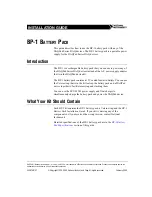
Page 8 of 8
Model:
BMPPT-150
200W Solar Charger
Booster Maximum Power Point Tracker
Operating Instructions
Please read these instructions before use
Unit 2, 110 Station Road, Seven Hills ,NSW, 2147, Australia
Warranty Conditions:
The product is warranted to be free from defects in materials and workmanship under normal use and service for a period of 24 months from the
date of sale. This warranty covers defective parts and workmanship provided that the product is shipped prepaid to the seller within 24 months of purchase of goods.
This warranty is limited to the repair or replacement (at the manufacturers’ discretion) of parts and shipping prepaid to the original despatch destination. We regret that no
liability can be accepted for consequential or special damages of any kind howsoever arising in connection with products supplied by the seller. This warranty is in lieu of
all other warranties expressed or implied. No representative is authorised to assume for the seller any other liability in connection with the seller’s products.
MPPT FAQs
Q: What is a BMPPT?
BMPPT stands for Booster Maximum Power Point Tracker and is a specialised converter designed to maintain the PV voltage at
the level in which it delivers maximum power to the load or battery while at the same time boosting the output voltage above the
input. The nominal panel output power can only be ensured with the use of an BMPPT.
Q: When is the BMPPT required?
The BMPPT is required when the panel voltage is below the battery voltage such as when a 12V panel needs to charge a 24V
battery.
The BMPPT enables the parallel connection of panels which can make the system more tolerant to partial shading when compared
to series panel connection.
Q: What output can I expect from a 150 BMPPT?
The maximum bulk charge current with a 24V battery and 150W panel is approximately 6A, so you can expect about 24AH per day
which is a close to 60W load for about 10 hours.
Q: Why are BMPPT used mainly in high power systems?
Until now and despite their overwhelming advantages BMPPTs have been excluded from low power systems because of cost. The
new GSL BMPPT specifically designed for low power makes economic sense even in small systems.
Q: What sort of batteries should I use?
1. A deep cycle battery is a must due to the cyclical nature of solar systems with a recommended battery capacity of at least
100AH.
2. A larger battery will not only give longer run time during low light but also will be able to avoid available PV power being
unstored such as when the battery reaches the float stage.
Q: How does PV temperatures affects charge current?
Temperature increase brings down the PVs maximum power point voltage resulting in lower panel output.
Q: What is the smallest panel size for the BMPPT-150?
The smallest panel size recommended for the BMPPT-150 is 10W, below that level the BMPPT will not function effectively.
Q: Is interference possible? and If so what do I do?
GSL’s BMPPTs produce far less interference than conventional solar regulator during the absorption and float stages, that
is during most of its operating time, and its designed to comply with local and international EMI standards however some
interference is still possible. If interference occurs first try and reorient the aerial or move the sensitive equipment away from the
BMPPT wires. Ensure the BMPPT chassis is grounded. Grounding a battery terminal may also help and finally you can try adding
ferrite clamps.
BMPPT-150-R4


























